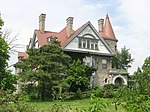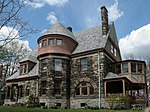Roger Bacon High School
Roger Bacon High School is a high school in St. Bernard, Ohio, United States, based in the Franciscan tradition. This high school was dedicated in 1928, and was under the administration of and staffed by the Brothers and Priests of the Order of Friars Minor, and lay men and women. The school was named in honor of Roger Bacon, a Franciscan friar and English philosopher who placed considerable emphasis on empiricism, and has been presented as one of the earliest advocates of the modern scientific method. Our Lady of Angels High School was the sister school to Roger Bacon, and was located several hundred yards northeast from campus. OLA was also dedicated in 1928, and due to changing demographics and smaller enrollment, closed its doors for good after the graduating class of 1984. (Google Earth lists OLA, even though the school has closed and the building has been torn down.) That year, Roger Bacon High School became co-educational, and Roger Bacon welcomed the Our Lady of Angels students and alumnae into their family. The class of 1988 was the first four-year co-ed class to graduate from Roger Bacon High School.
Excerpt from the Wikipedia article Roger Bacon High School (License: CC BY-SA 3.0, Authors).Roger Bacon High School
East Mitchell Avenue, Cincinnati North Avondale
Geographical coordinates (GPS) Address Nearby Places Show on map
Geographical coordinates (GPS)
| Latitude | Longitude |
|---|---|
| N 39.162777777778 ° | E -84.5025 ° |
Address
Roger Bacon High School
East Mitchell Avenue
45229 Cincinnati, North Avondale
Ohio, United States
Open on Google Maps









